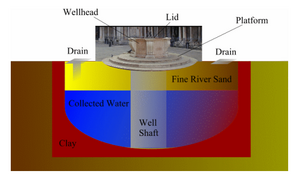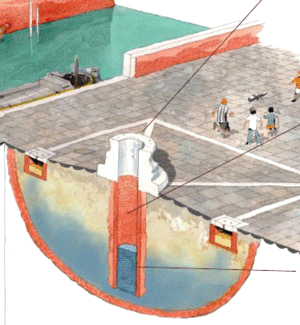Wellhead
This page contains information about a typical Venetian wellhead.

Historical Source of Fresh Water
The rainwater collection system that early Venetians developed was both an effective and practical way to acquire fresh water. Rainwater would be discharged into the squares from the roofs of buildings by a series of stone gutters and lead pipes. From here the water would run to one of the four corner stones surrounding the wellhead, these were perforated stones that were on a slightly lower elevation than the rest of the square (to act as a funnel). The water was then filtered through layers of fine white sand buried beneath the corner stones, in order to sanitize and free the water of any impurities[2]. After the filtration process, the water would then reach a cistern that would collect and store the fresh water beneath each wellhead. Buckets could then draw up water through the well shaft that connected the cistern to the wellhead[3].
Materials
Wellhead
All but two of the 217 public wellheads cataloged are composed exclusively of Istria stone, Red Verona marble, or White Verona marble. Istria is stone the most common material, accounting for 79 percent of the wellheads cataloged. Istria is followed by 14 percent Red Verona marble, and seven percent White Verona marble[4]. Istria stone is a type of limestone that has a gray-green or yellowish color. Lengthy exposure to the atmosphere causes the stone to obtain a whitish appearance through a process called “whitewashing.” Unfortunately, this also makes Istria stone a prime candidate for exfoliation. Verona marble is a sedimentary rock composed of organic limestone and fossils. It has either a reddish or whitish color depending on the carbon compounds it contains.

Well Shaft
While functioning as Venetians main water supply, the actual well shaft that extended from the wellhead to the cistern was made from bricks and lined with a layer of impermeable clay[5].
Cistern
The cisterns were made with large stones and then lined with impermeable clay that prevented the fresh water from leaking out and more importantly prevented salt water from leaking in and contaminating the water supply[6].
Current Water Supply
Venice is now supplied with water from the mainland, traveling underground through pipes from the commune Trebaseleghe which is filled by 120 artisan wells[7].
See also
References
- ↑ Blackwell, Lewis et al. Preserving Venetian Wellheads. 2000. Pg 21
- ↑ Venice, The 1911 Classic Encyclopedia, Last modified October 21, 2006, http://www.1911encyclopedia.org/Venice
- ↑ Insula spa and Matteo Alemanno, Venice Preservation and Urban Maintenance( Venice, Italy: Grafiche Veneziane)
- ↑ Blackwell, Lewis et al. Preserving Venetian Wellheads. 2000. Pg 26 – 27
- ↑ Insula spa and Matteo Alemanno, Venice Preservation and Urban Maintenance( Venice, Italy: Grafiche Veneziane)
- ↑ Insula spa and Matteo Alemanno, Venice Preservation and Urban Maintenance( Venice, Italy: Grafiche Veneziane)
- ↑ Venice. The 1911 Classic Encyclepedia. October 21, 2006. http://www.1911encyclopedia.org/Venice
Bibliography
NULL